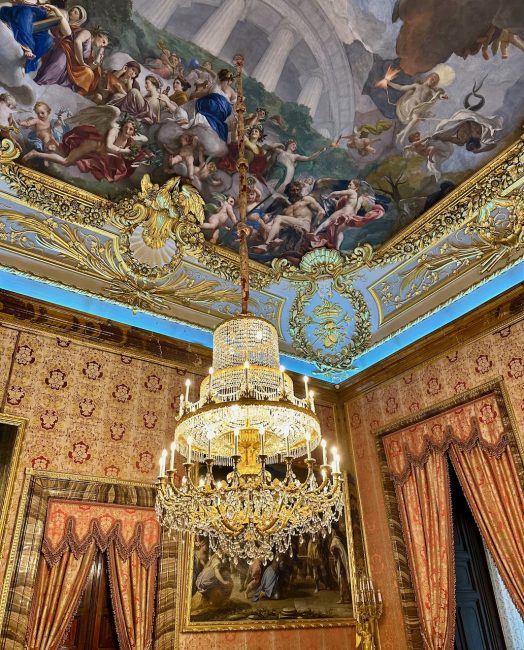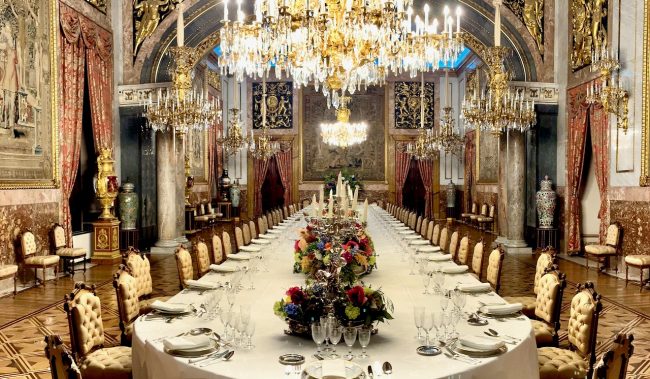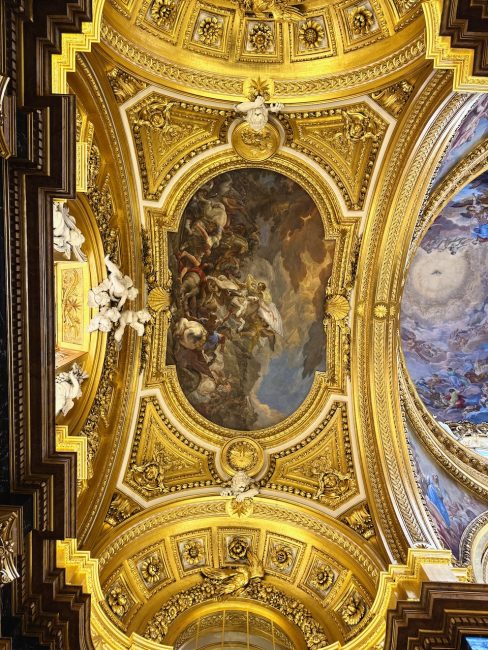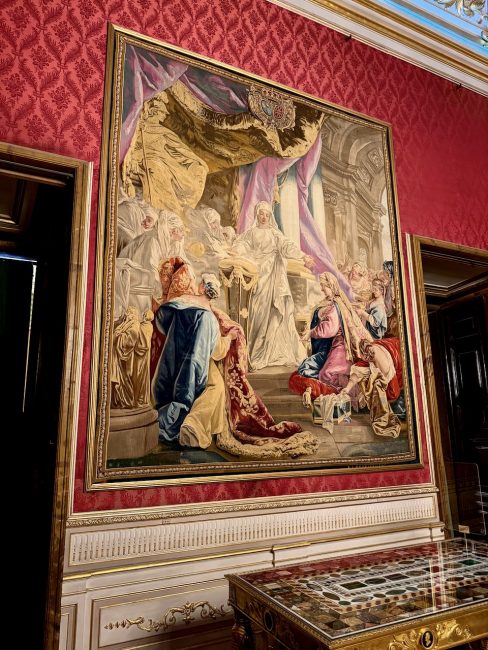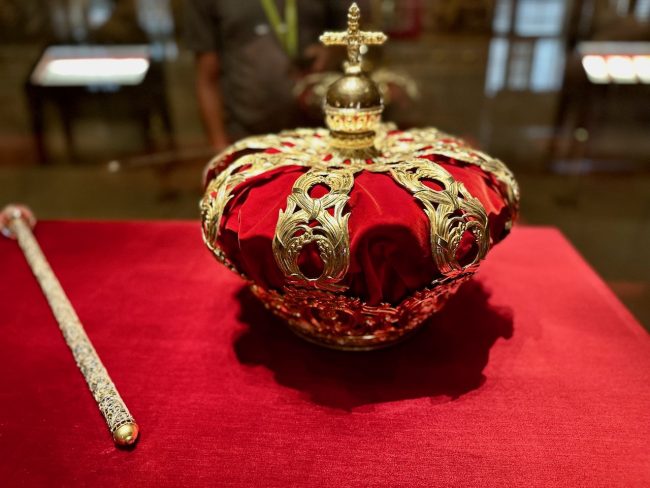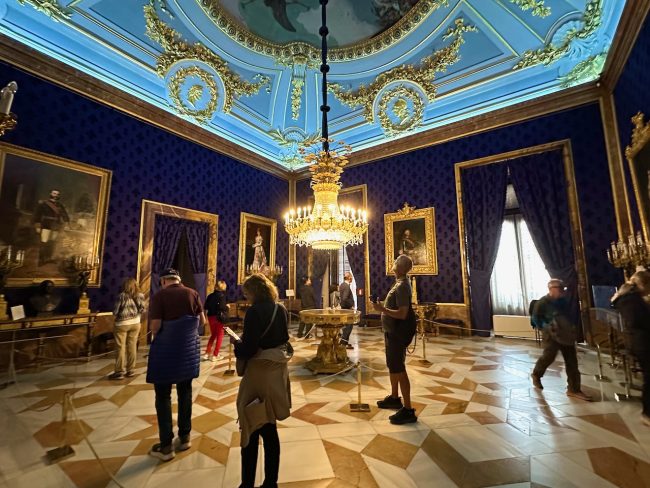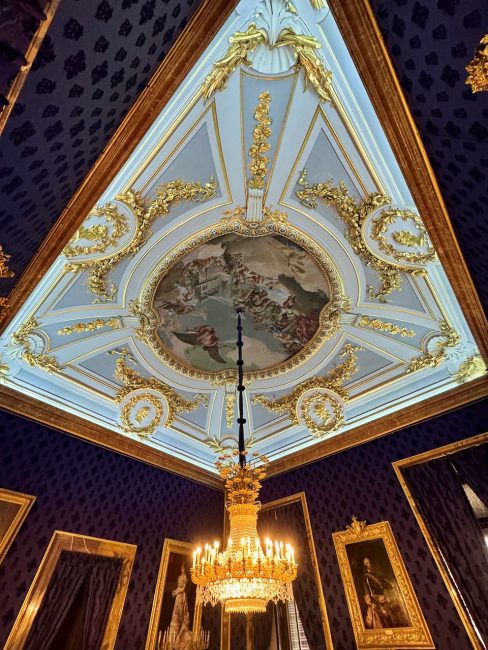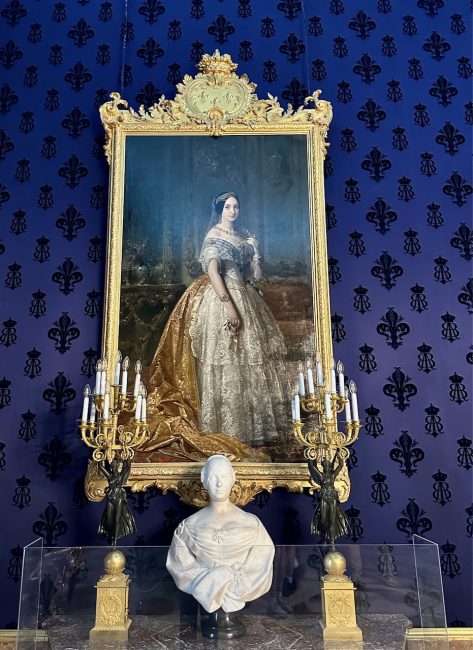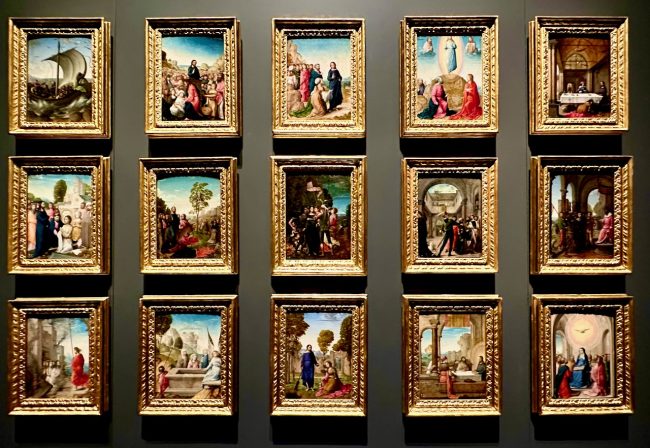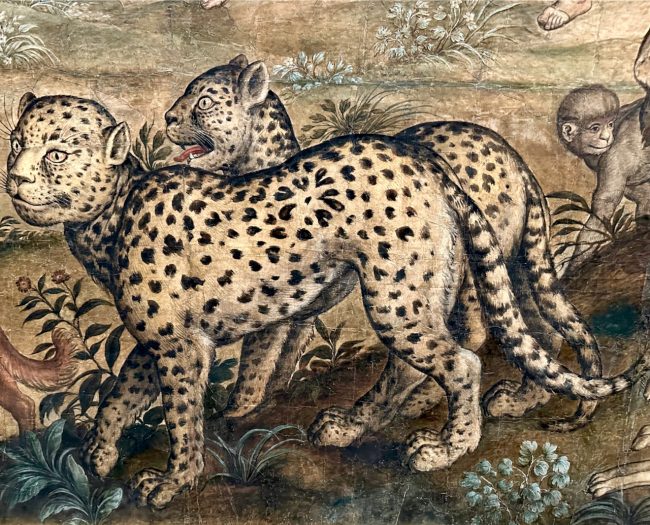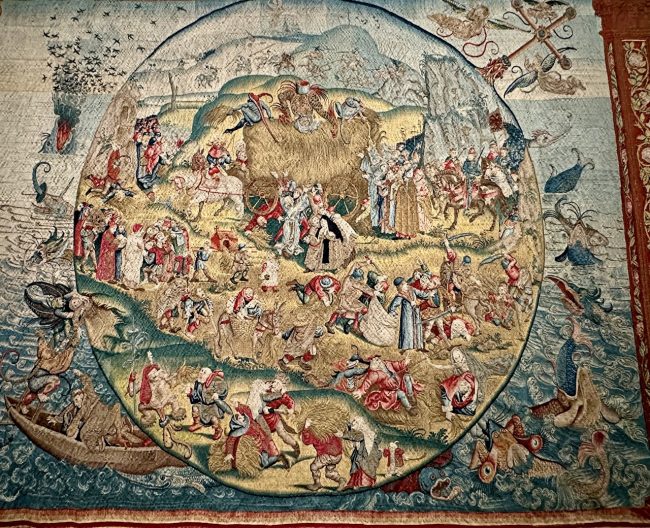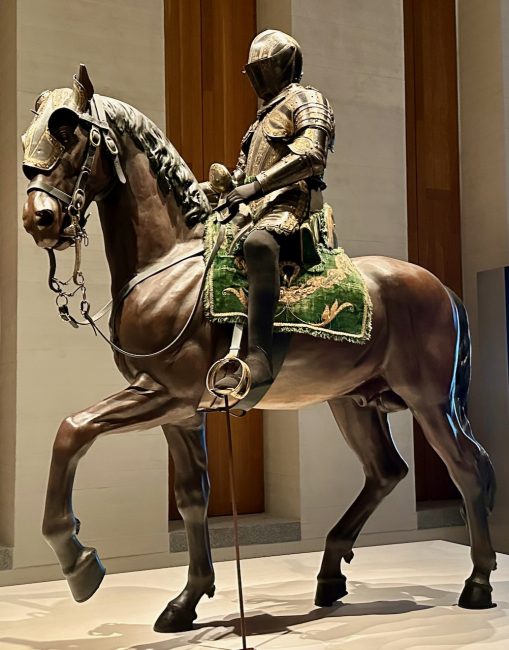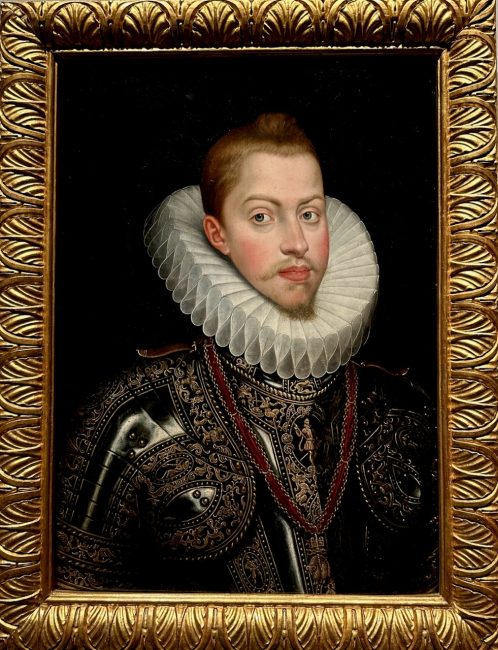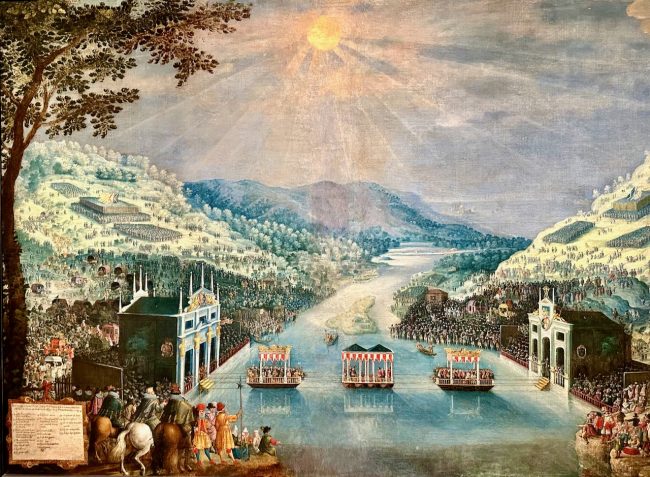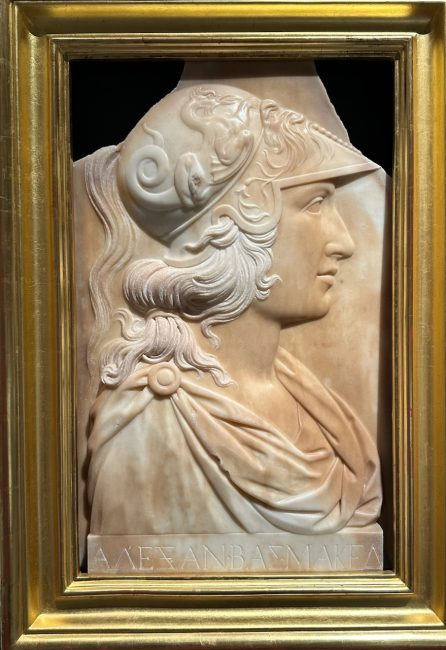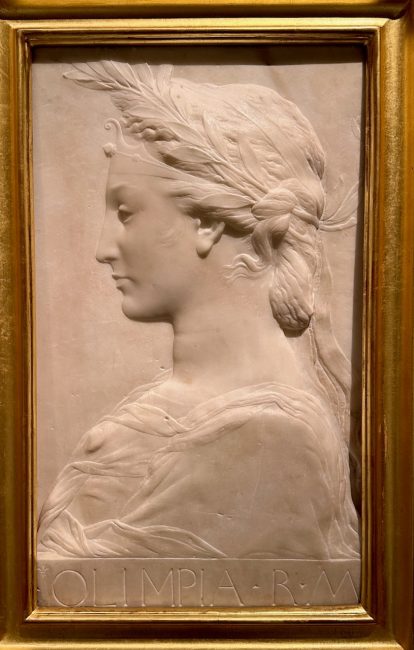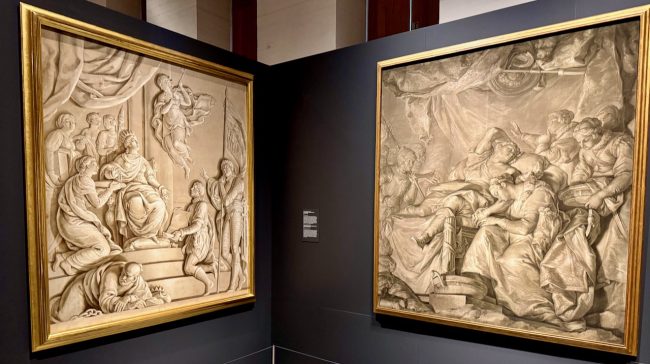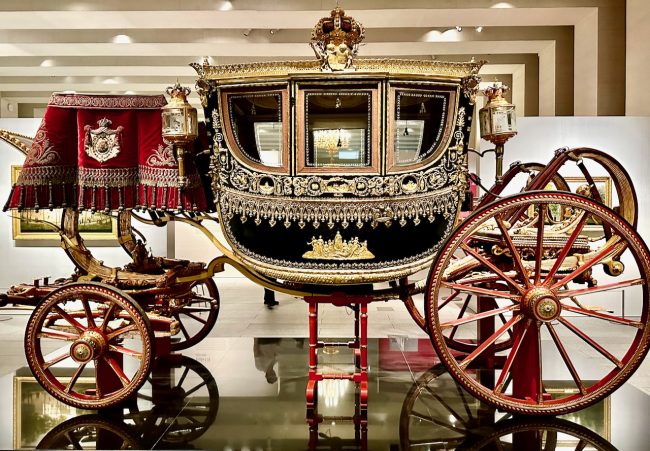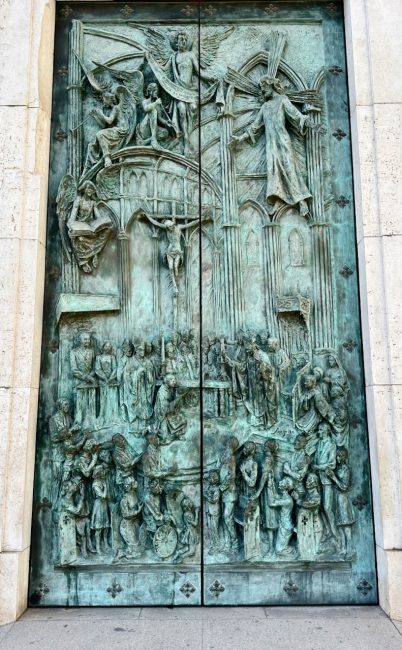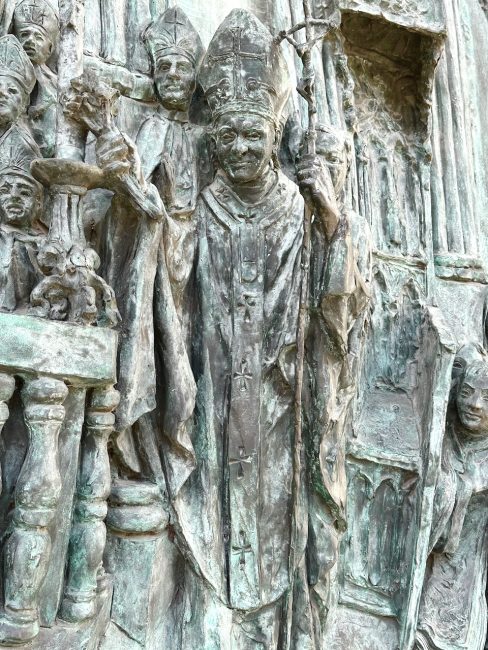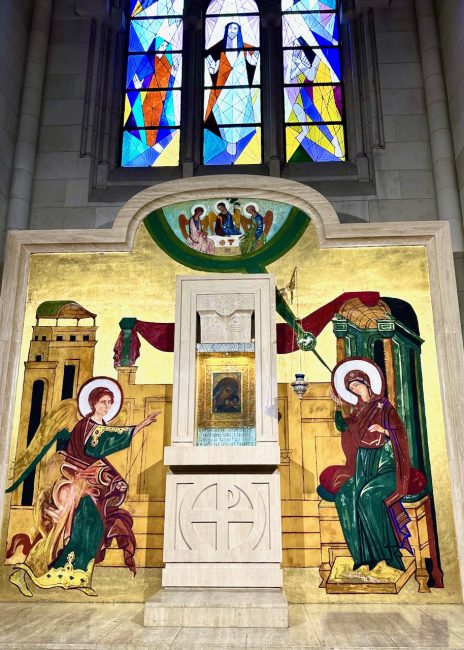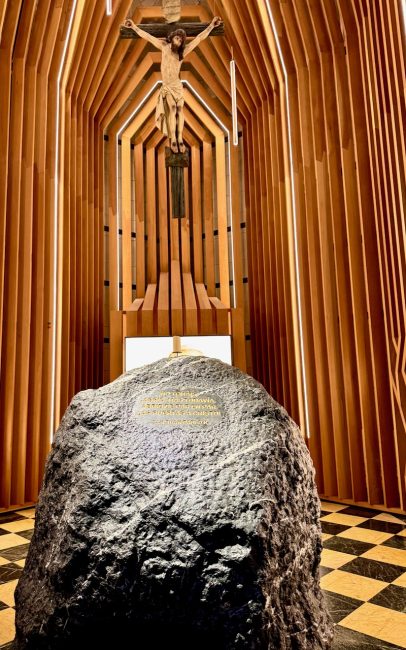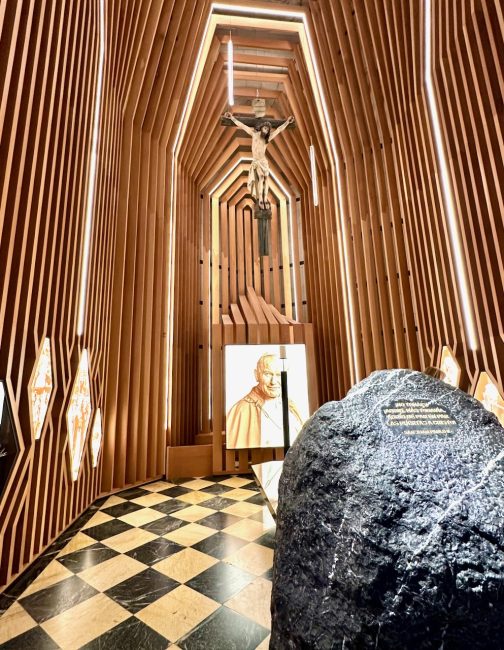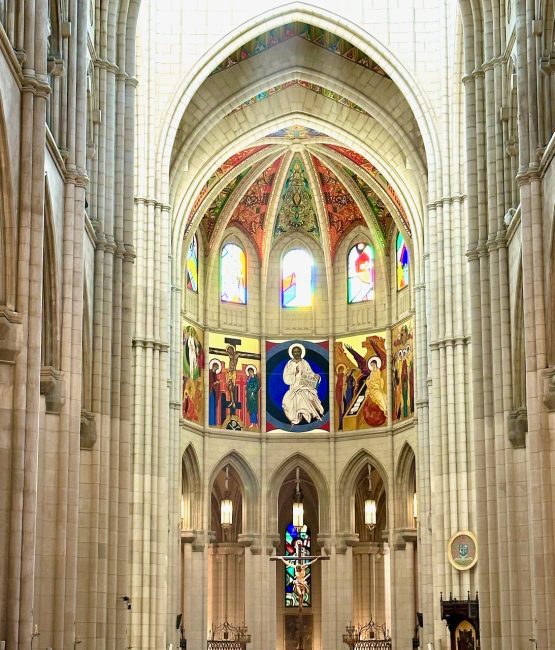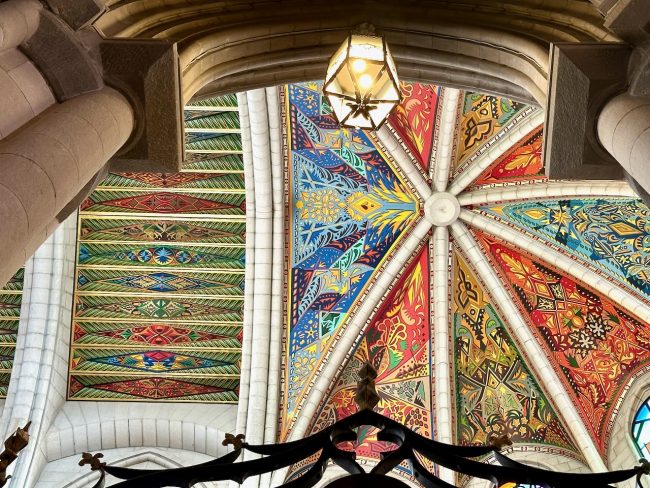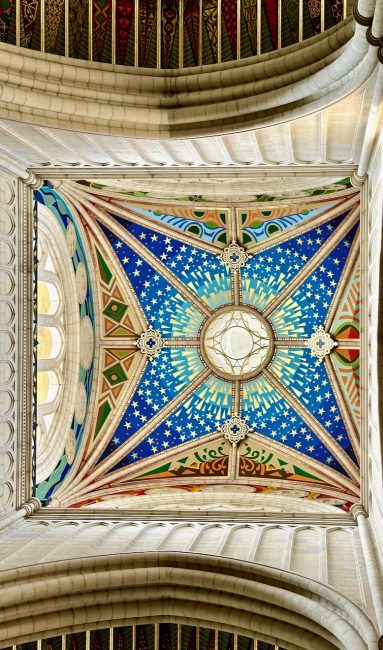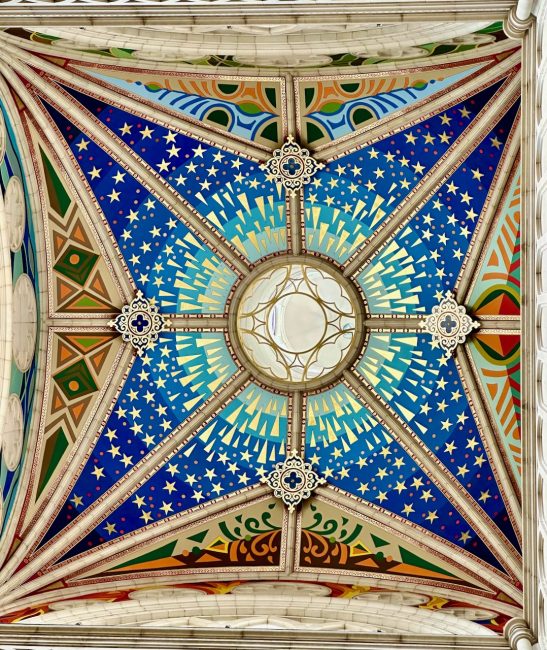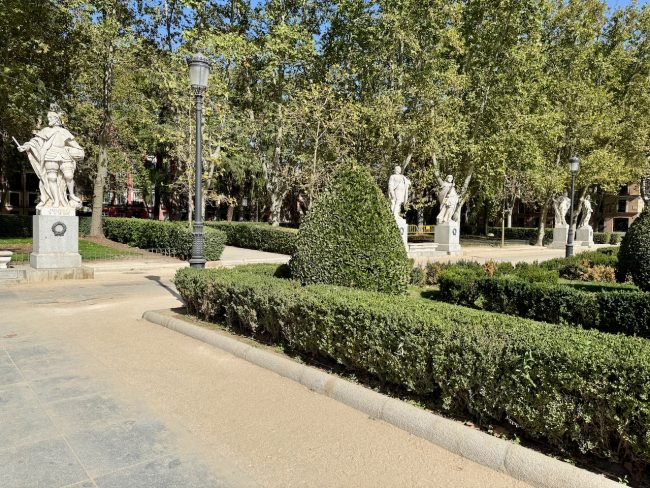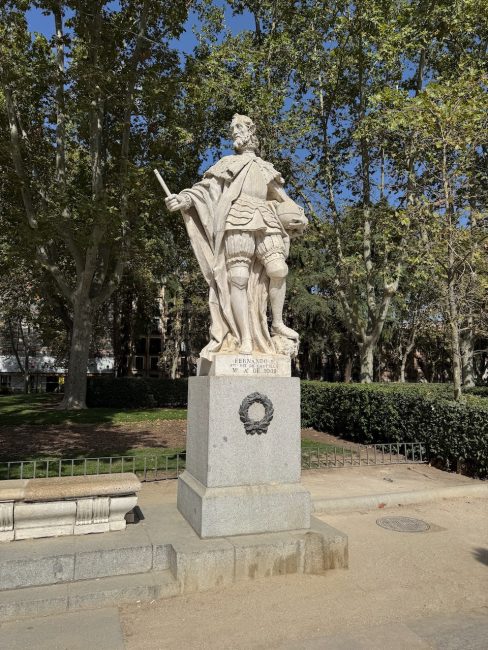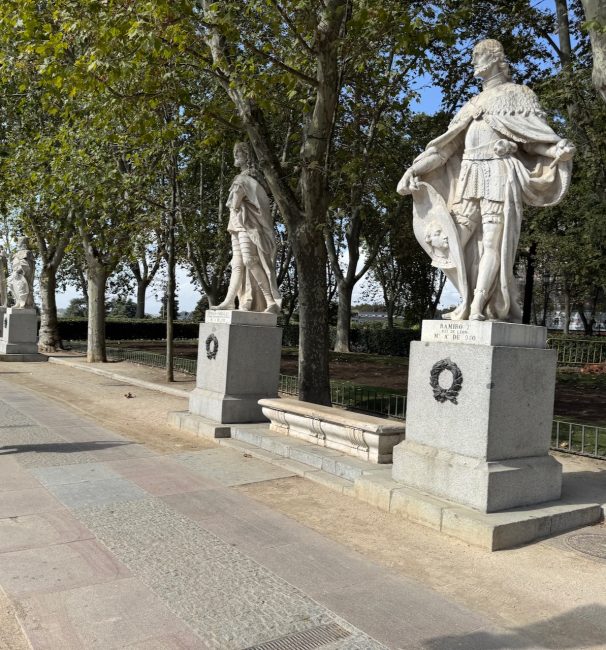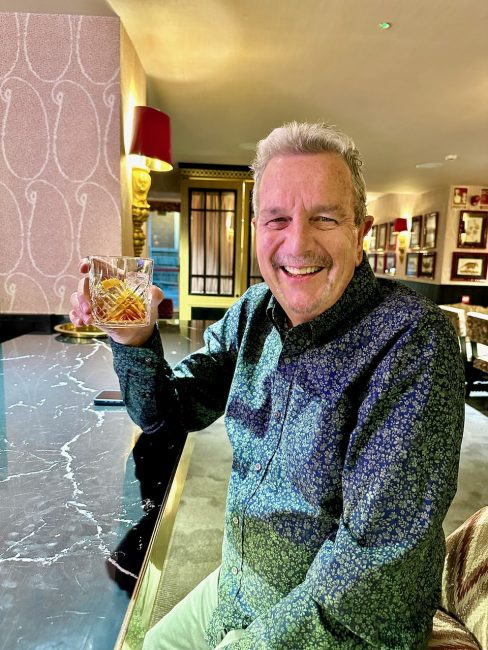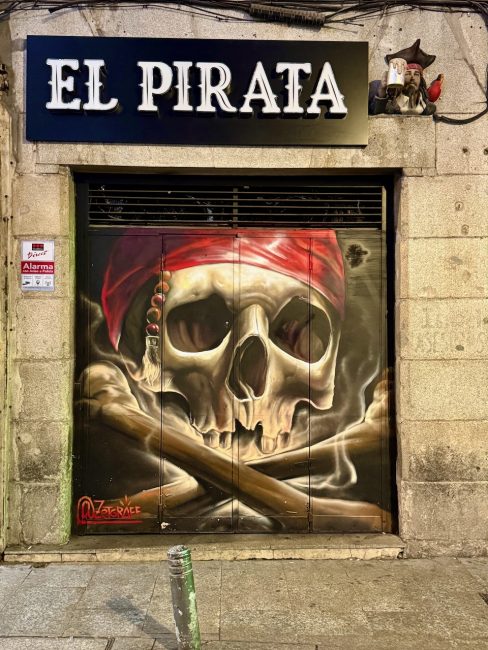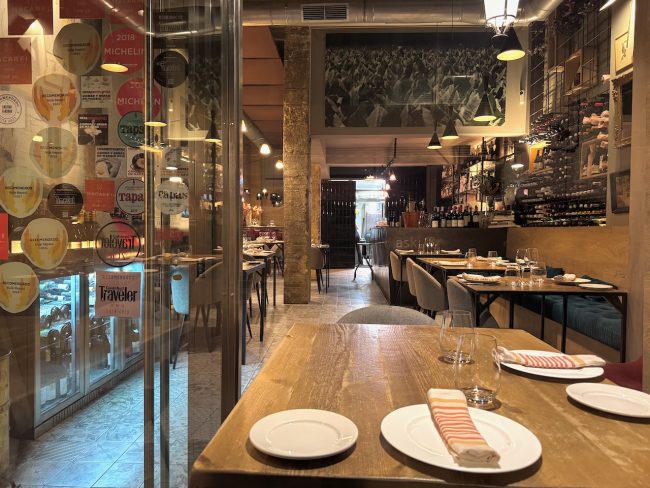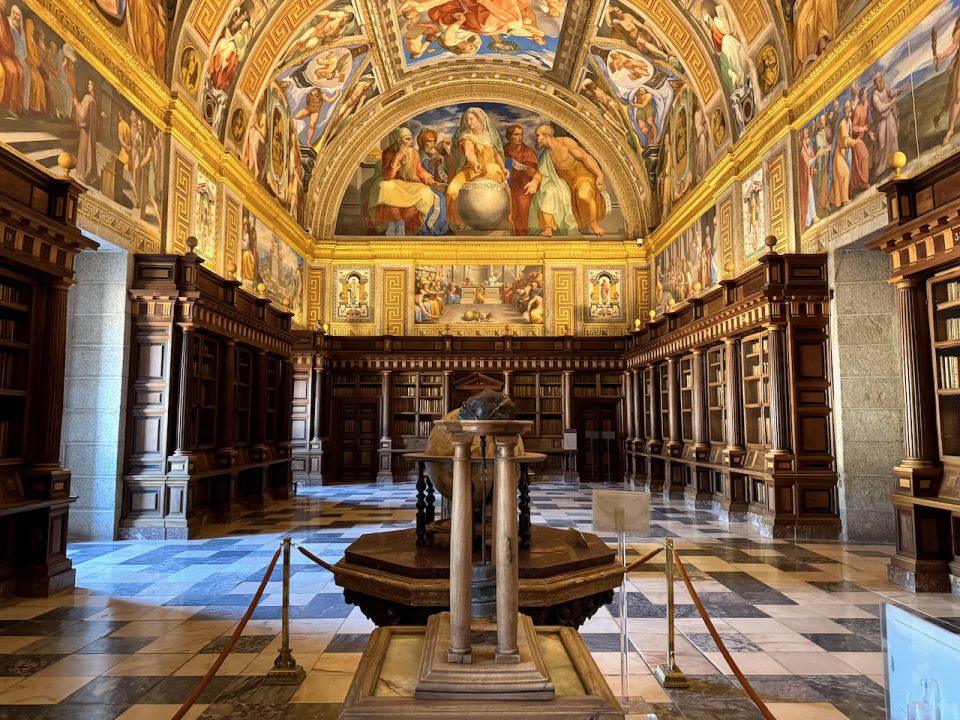
Chapter One: Viva Madrid!
November 11, 2025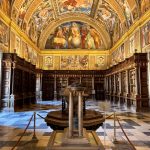
Chapter Three: Royal Site of San Lorenzo de El Escorial
December 7, 2025Celebrating España: MaiTaiTom’s Still “Insane For Spain”
Chapter Two – A Day Fit For A King & Queen
Day Two: Clean Sweep, Touring The Largest Palace In Western Europe, Saving The Best For Last, A Royal Surprise, Things Are Looking Up, My First Bosch Sighting, Let The Tapas Begin, A Not-So-Old Royal Cathedral, A Visit To The Oriente, An Old Fashioned Love Song, Meeting Maribel and “Meating” Dinner
A good night’s sleep helped us adapt quickly with no jet lag, and on a Monday morning we would take the nearly 20-minute walk from Room Mate Alba to El Palacio Real de Madrid, our first of three royal sites we would visit on this day.
Not far from our hotel, I spotted an old friend with a push broom we met back in 2015, who was still “working” at the Plaza de Jacinto Benavente. Monumento Al Barrendero Madrileño, a sculpture dedicated to Madrid’s street sweepers that has been located here for nearly 25 years.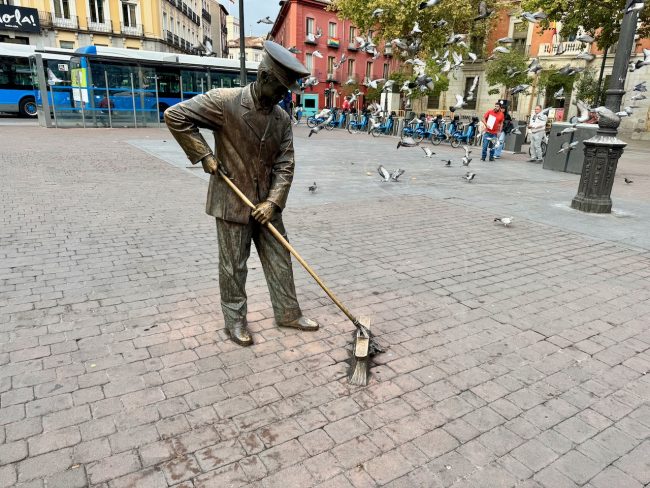
We decided to take a slight detour through the Plaza Mayor (still cleaning up from last night’s festival) to take a photo of the 16th century equestrian statue of Philip III, which has been located in Plaza Mayor since 1848.
At Plaza de Ramales we checked out the 100+-year old Casa-palacio de Ricardo Augustín. We learned the memorial on the square is for famed Spanish painter Don Diego Velázquez, who was buried in the San Juan Batista church crypt in the 1600s. The church was taken down in the early 1800s, leaving Velázquez and his wife buried under the square.
We had 10 a.m. timed entrance tickets for the Royal Palace, which sits on the site of an old Alcazár that burned to the ground on Christmas Eve in 1734. The first stone of this palace was laid a few years later. We had purchased tickets online a few weeks before our trip.
Across the courtyard stands Catedral de Santa María la Real de la Almudena, where we would visit later in the day.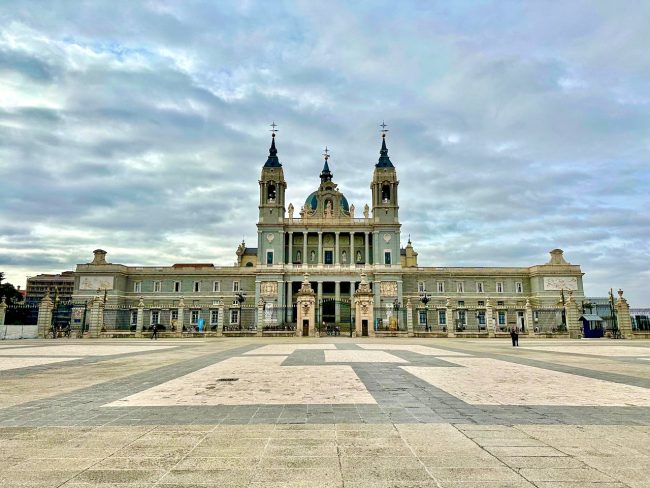
When we visited in 2015, the palace rules were stricter with guided tours only and no photos allowed. On that tour, both Kim and I were stampeded by two different tour groups, one nearly pushing me into a priceless vase. When I read photos were now allowed and you could purchase an audio guide to tour at your own pace, I jumped at the opportunity to see the palace again. I highly recommend purchasing tickets before arrival, as you may get shut out, or have to wait in the very long ticket line.
After viewing a statue of Carlos III at the grand entrance …
We ascended the Main Staircase made entirely of Carrara marble, where we were greeted by a statue of Carlos IV attired in a Roman toga. I decided it was too early for Animal House jokes.
The ceiling fresco at the top of the staircase is called The Triumph of Religion and the Church. It would be the first of many.
The palace contains more than 3,000 rooms, and although the royal family doesn’t live here, it is used for state ceremonies (one had been held the previous day for Fiesta Nacional de España). Obviously our invitation had been lost in the mail. Fortunately, not all of the 3,000+ rooms are available for touring, so here is a smattering of the ones we did see. Not only is the palace the largest in Europe, it ranks as one of the biggest in the entire world.
The Hall of Columns formerly known as the Banqueting Room, hosted a number of state ceremonies. I asked Tracy if we needed an Excel spreadsheet to add up all the columns, and she quickly exited to the next room. It is actually called that because of their beautiful marble columns.
The first apartment was the Anteroom of King Charles III (who moved into the palace in 1764), where he would meet guests under huge French chandeliers and a frescoed ceiling.
Charles’ antechamber is decorated with Spanish silks. Goya painted the portraits on the wall, while 1773’s The Apotheosis of Hercules hovers above.
We were going to try to get ahead of the crowd, however the beauty of the Gasparini Room (named after the person who designed it) stopped us in our tracks. The audio guide related that after the Throne Room, this room where monarch’s held private audiences, was the next most important room. So complex to design, Charles didn’t live long enough to see this room completed.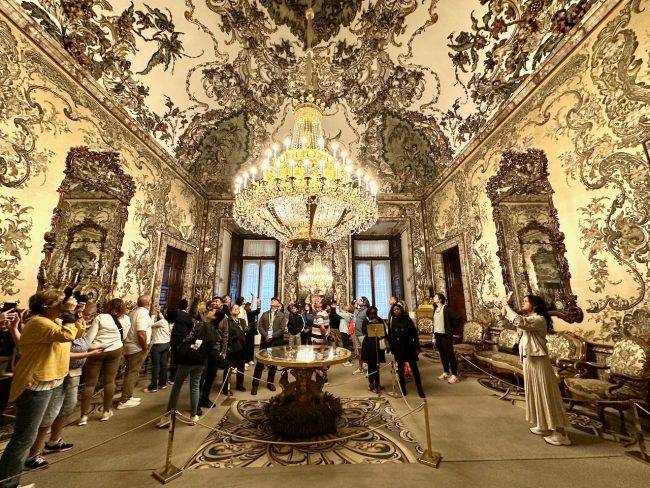
I guess he just ran out of time.
Now one step ahead of the crowd, we paused to admire The Yellow Room (self-explanatory) and the Porcelain Room, whose walls and ceiling are covered with porcelain panels.
We were now in part of the Queen’s apartments. The Banqueting Hall was finished in 1879. 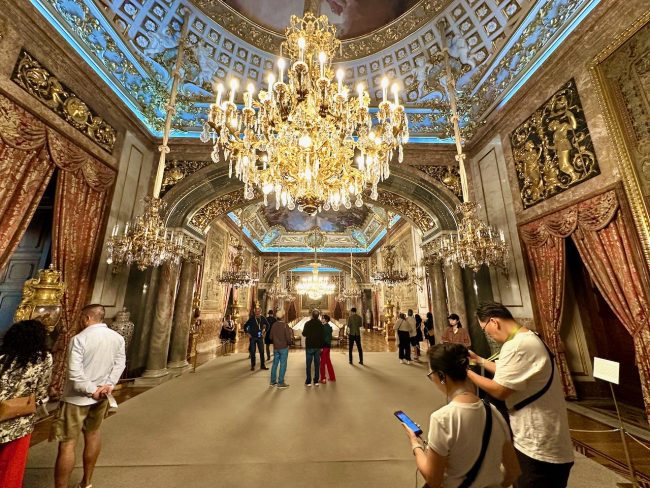
I wonder if they’d let us borrow this room for Thanksgiving.
Next stop was the Royal Chapel, completed in 1757. I had my first St. Michael sighting on the high altar, which has been here since the late 18th century.
The ceiling frescoes date back to the mid 1750s. It had more golden arches than McDonald’s.
We visited the anteroom of Queen María Cristina, which contained a number of musical instruments.
We pulled a view strings and viewed several instruments of Antonio Stradivari.
The Crown Room includes the crown (of course) of Charles III and his sceptre, along with his original throne.
Right on cue, we saw the Billiards Room. When I tried that line on Tracy, all she could say was, “Give me a break.”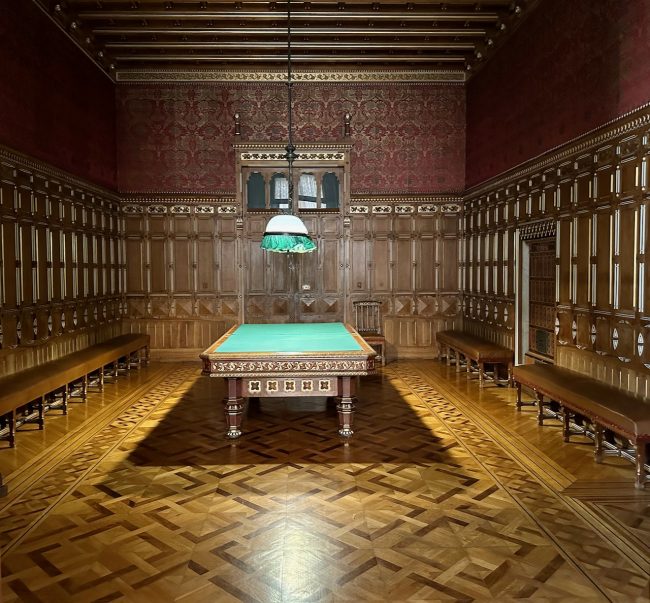
The Smoking Room of Alfonso XIII was full of embroidered panels made in China in the 19th century.
I did not know what a Camón was until I saw the sign that it’s an enclosed balcony with a view.
There were still a few more rooms left to go.
Entering the Official Antechamber …
… our eyes were immediately drawn to the ceiling and its fresco, The Conquest of the Golden Fleece. Maybe that’s because Jason and the Argonauts was one of my favorite movies as a kid.
There are also court portraits hanging in this room.
Lots of anterooms in the palace, but according to the sign this was the “Official” one. 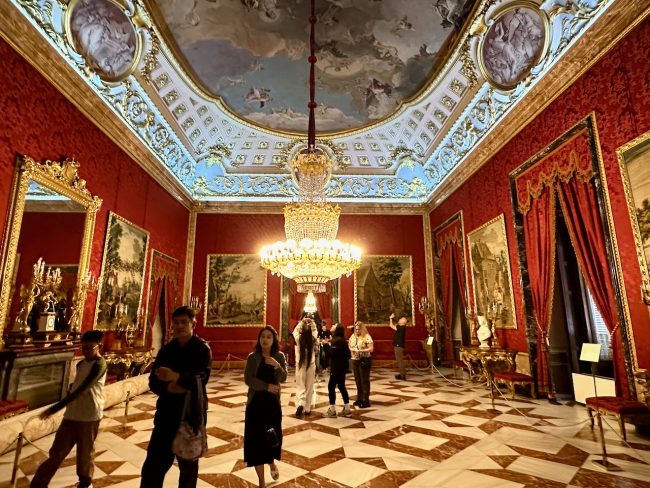
The tapestries depict scenes from Flemish life.
We were finally in the room where it happens … Salón del Trono (aka The Throne Room). It’s so important that it has three names (also the Hall of Realms and the Hall of Ambassadors). The very large ceiling fresco from 1764 is the Triumph of the Spanish Monarchy, by Tiepolo.
Red velvet walls, lions (of the bronze variety), sculptures, candlesticks, clocks, mirrors and large chandeliers, it truly is a room fit for a king.
Those two thrones are 20th century replicas of King Charles III’s throne.
One last glimpse of Zeus riding on an eagle ready to throw a lightning bolt, and we mere mortals were done.
But not for long.
When on the Palacio Nacionale website, I had purchased a combo ticket which included not only the palace, but the recently (2023) opened Galería de las Colecciones Reales, which united more than 700 works of art spanning five centuries which had been scattered among the Spanish Crown’s numerous royal sites. Like the Carpenters, we’ve only just begun our journey through Spanish history, and it was just like yesterday once more.
It’s just a short walk from the palace to the entrance of the building, which is cool because, as we read, the structure is carved out of rock “from the Campo del Moro gardens to the Armería Square.” Although the building was completed in 2016, because there wasn’t enough money to complete the interior, it did not open until June 2023.
Down, down and down the ramps we walked to Floor -1, where we would visit the Austrias (Habsburgs) period.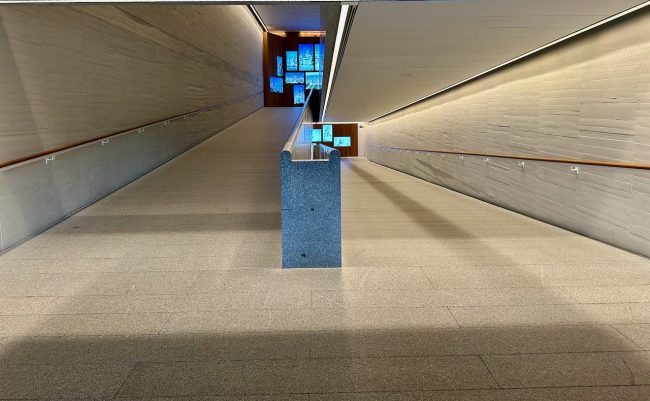
Art and artifacts on this floor cover the 15th – 17th centuries. Isabella I’s (aka Isabella The Catholic Queen) portrait and a polyptych of 15 panels for her devotional use were among the first things we saw in this area.
King João III of Portugal owned the Hercules Supporting the Celestial Sphere tapestry that “commemorated the great deeds of Portuguese seafarers.”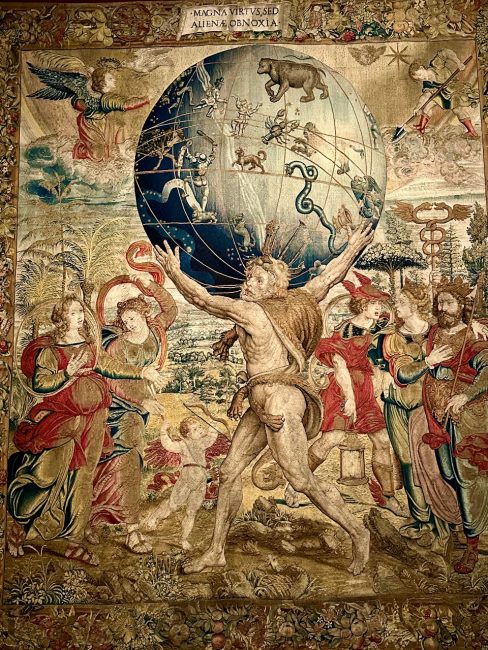
No unicorns could be found in the tapestry Animals Entering The Ark.
Luckily for our front yard, there were two squirrels.
King Philip IV was a big patron of the arts, and this painting by El Greco was sent to El Escorial (the royal monastery near Madrid that we would visit the following day) in the mid-1600s.
What do you get when you combine two of my favorite artists, Hieronymous Bosch and Peter Bruegel? The Tribulations of Life (aka The Haywain) cartoon tapestry by Bruegel is based on El Bosco’s paintings Garden of Earthly Delights, The Temptations of Saint Anthony, The Haywain, along with Saint Martin and the Beggars. This is part of a 16th century tapestry series.
Joining the collection from El Escorial is the Madonna of Silence, who was not a material girl.
Charles V’s saddle and Philip III’s armor both tell pony tales to stirrup ancient memories.
This “Candelabra” fountain has everything but Liberace. Speaking of Philip III.
A few of my favorite paintings as we wandered through the Habsburg section.
The Musical Angels tapestry based on a design (cartoon) by Peter Paul Reubens was originally created for the church of the convent of Los Descalzas Reales, which we would also visit on this trip.
In the late 1600s, Luisa Roldán also known as La Roldana, achieved acclaim that was very unusual for a woman at the time. Charles II appointed her court sculptor (first woman to do that), and her Saint Michael is one of her crowning achievements.
We checked out the Black Carriage which carried Mariana of Austria, the second wife of Philip IV.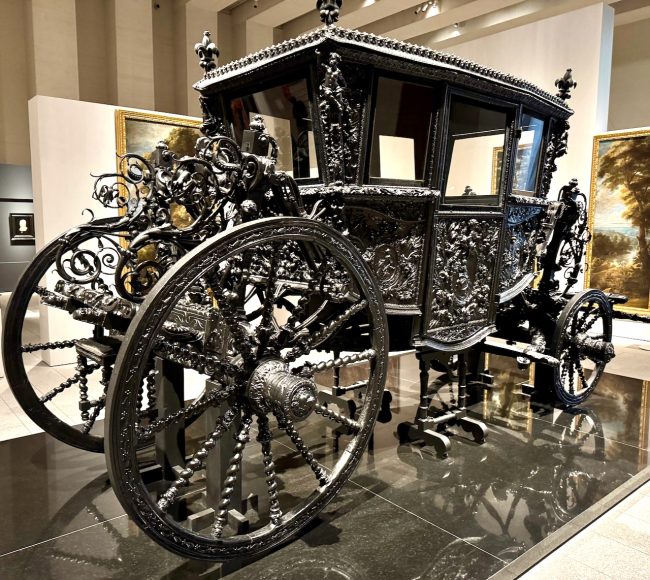 More from the collection was an Equestrian Portrait of John of Austria. the Head of John The Baptist and White Horse from famed Spanish artist Diego Rodríguez de Silva y Velázquez.
More from the collection was an Equestrian Portrait of John of Austria. the Head of John The Baptist and White Horse from famed Spanish artist Diego Rodríguez de Silva y Velázquez.
Finished with the Habsburg section, it was now time for some Bourbon, as in Spain’s Bourbon Dynasty, which has ruled the country (for the most part) since the early 1700s. Of course, all the Bourbon pieces here are Old Fashioned.
This Equestrian painting is of Philip V, whose total reign was the longest (45+ years) in the history of the Spanish monarchy. Talk about the reign in Spain. This painting spent many years at La Granja de San Ildefonso, which we would visit as a day trip from Segovia. It shows Philip as a warrior.
Opposite Philip is Isabella Farnese, who was born in Parma, Italy, and became Queen of Spain when she married King Philip V.
A very cool tapestry on the horizon was a scene from Cervantes’ The Ingenious Gentleman Don Quixote of La Mancha, featuring Don Quixote and Sancho Panza, complete with windmills in the background.
This was offset by the Death of Absalom, who rebelled against his father King David only to have his whose hair get caught in a tree, where he was killed by three spears to the heart thrown by David’s commander. By the way, David was not happy he was killed.
Sometimes when a king took a road trip, he might want to pray. But what if there’s no church? Not to worry. Philip IV brought his own portable altar, which included three oil paintings. It was even used for the baptism of Infante Luis Alfonso, Prince of Bavaria, in the Gasparini Room of the Palais Royale. The late 18th century desk even had a mechanical system, which could raise the side modules. It’s good to be king!
Philip V purchased The Suicide of Lucretia from the private collection of one of Rome’s premiere artists, Carlo Maratta.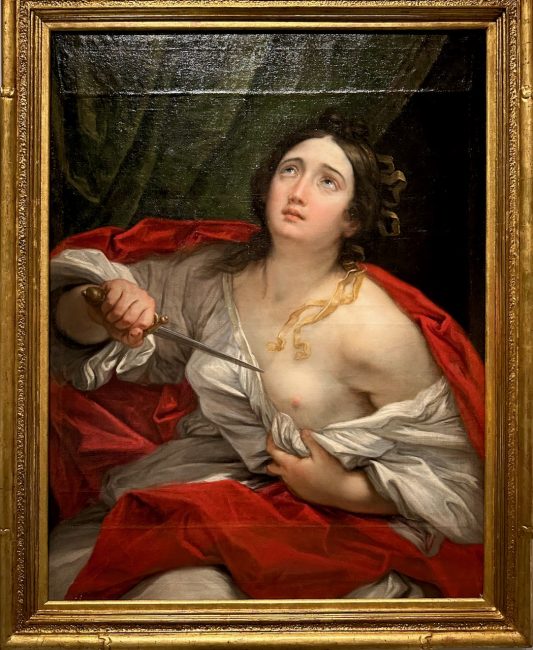
Alexander the Great and his mother were shown in these very intricate reliefs.
Although this room (like the one for the Asturias) is huge, areas are partitioned off so it feels smaller and not so overwhelming.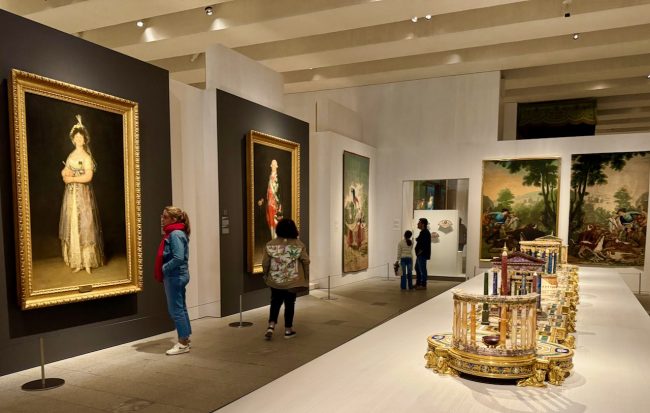
I had never heard of a technique called Grisaille until we visited here. We liked it, whatever it was.
The portrait of Philip The Good is from the Workshop of another of my favorites, Rogier Van Der Weyden.
One good carriage deserves another. This Carriage of the Royal Crown (no connection to the cola) was ordered by Ferdinand VII.
Charles III is the main subject of these two paintings …
… while Patron Saints of Spain, The Monarchs and Pope Pious IX round out this painting.
Finally, we admired The Allegories of Peace.
Tracy and I loved this museum. It was well thought out, and the pieces held our interest all the way through. It would be one of our favorite museums in Madrid on this trip, but not THE favorite. Hint: It was not the Prado.
We walked outside to what was now a beautiful sunny day.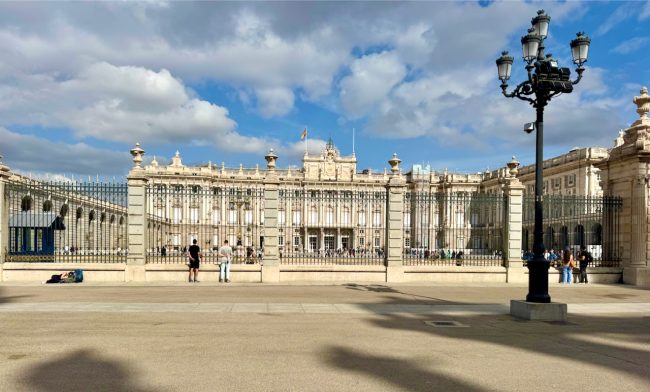
We’d only grabbed a quick coffee and croissant for breakfast and were starving, so we headed to the nearby El Anciano Rey de Los Vinos, founded in 1909, for lunch (aka tapas). We took a quick look at the interior …
… before plopping down on the patio (well, we actually sat at a table).
Munching on ham croquettes and patatas bravas washed down with a little vino, while looking out at Catedral de Santa María la Real de la Almudena, and we knew it was time to hit our final big stop for the day.
In 2015, we had marveled at the church’s colorful ceilings, so returning was never in doubt. Although the plans for the cathedral were drawn up in 1879 and construction began in 1883, it was not consecrated until 1993. And it was no regular consecration. Almudena Cathedral was consecrated by Pope John Paul II, becoming the first cathedral to ever be consecrated by a pope outside of Rome.
The ornate bronze doors were sculpted at the beginning of the 21st century. You can see the relief of Pope John Paul II in the photo on right. The cathedral is the main church of the Archdiocese of Madrid.
In a little chapel as we entered we saw The Mystical Crown, the original painting of Our Lady of the Way, the Virgin of Camino.
The side chapel Chapel of Saint John Paul II contains a large rock, which serves as the altar.
Then, as Tracy’s neck not so fondly remembered, it was time to look up at the vibrant ceilings.
These were painted in the late 1990s.
Tracy took a break from looking up to walking up to the high altar, dedicated to the Virgin of Almudena (Virgen de la Almudena), who has been the patroness of Madrid since 1377. The 17th century polychromed wooden statue Virgin Mary holding baby Jesus draws quite a crowd.
The main altar showed off colorful frescoes …
… and even more colorful ceilings inspired by moorish designs.
Undaunted, Tracy again craned her neck to get even more ceiling shots.
I finally had to pull her away before her head became permanently tilted skyward.
Back on the ground stood one of Madrid’s oldest pieces of furniture (still not older than the couch at my first apartment), and (according to many experts) it is Europe’s most important medieval artifacts. The 13th century funerary chest (ark) once held the body of Saint Isidro.
Tracy broke away from me once more, and before I could yell, “Neck brace,” she tilted her iPhone skyward to take a couple of photos of what we read was a “deep blue ceiling dotted with stars to represent a celestial vault or the heavens symbolizing a holy or heavenly place. The inner dome’s ribs form a star pattern.”
One last stained glass window, and I whisked her away before we’d have to call a chiropractor.
We were going to walk around the corner to the cathedral crypt, the largest crypt in Spain, which is the final resting place for many of Spain’s noblest families, but it was closed until late afternoon.
Instead, since the day had turned so beautiful, we walked to the nearby Plaza de Oriente, which has three distinct areas, one of those being Jardines de Lepanto, with its geometric hedges. It was here we took a look at Monument to Captain Melgar, who perished during the African War in Melilla.
Plaza de Oriente displays a collection of statues of historical Spanish figures …
… including Spanish royalty.
It all centers around the central parterre, where you will find the Equestrian Statue of Philip IV.
From a stable resource, this is “the first equestrian statue in the world supported on the back legs of a horse.” It’s been riding high here since 1843.
It was now a little after three, and even I was tired. While in the neighborhood, we did see some interesting buildings, including Teatro Real, Madrid’s opera house, which opened in 1850. Guided and audio tours are available.
Nearing our hotel, we scoped out Teatro Calderón, a historic theater located in Plaza de Jacinto Benavente. I thought for a minute the building might disappear or be levitated.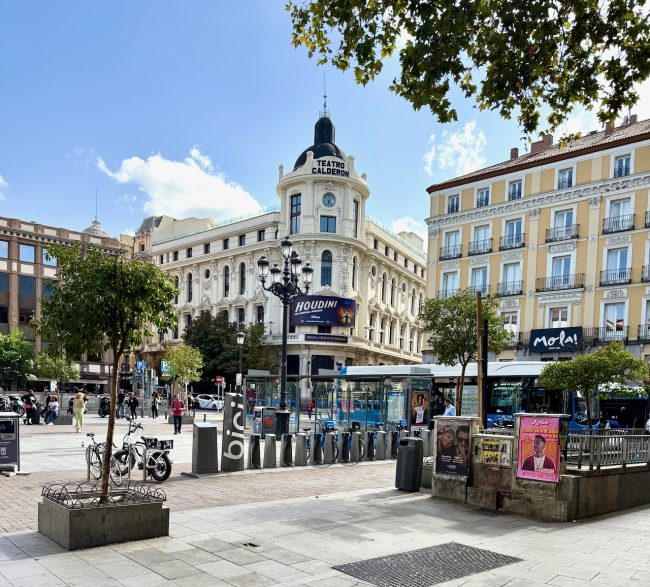
Amazingly, back at the hotel, I laid my head down a little after 4 pm. and the next thing I knew it was after 6 pm. According to my late mom, I never took a nap that long after I was six months old.
We had to freshen up, because on this evening we would meet someone who has given me so many travel tips, especially concerning Spain and Portugal. But first, we stopped by the hotel bar and met Sebastián, our bartender for the next couple of nights at Room Mate Alba. Pouring one of the finest Old Fashioned coktails I’ve tasted in quite some time, I knew we would be repeat customers.
Walking to our restaurant we passed Pub El Pirata. For some reason I wondered if they had planked salmon.
The brightly lit building is the Galería Canalejas complex that we were told we could find some high end shops and a Four Seasons Hotel.
When we made this turn, for a split second I thought we might be in Amsterdam.
Shortly we arrived at our restaurant, Askuabarra (Calle Arlaban 7), where we would meet my online travel guide Maribel and her husband Philip. I told Philip I had seen his statue in the Place de Oriente, and I believe they wondered what they had gotten themselves into.
Unlike myself, Maribel is a real professional travel planner who can help prepare your travel plans. Her website states “For The Sophisticated Traveler,” so we knew this might be a step down in class for her this evening.
She and Philip were a delight, as was the dinner. Nobody who has dined at Askuabarra has ever asked, “Where’s the beef?” Actually, it was an all beef dinner, starting with Steak Tartare …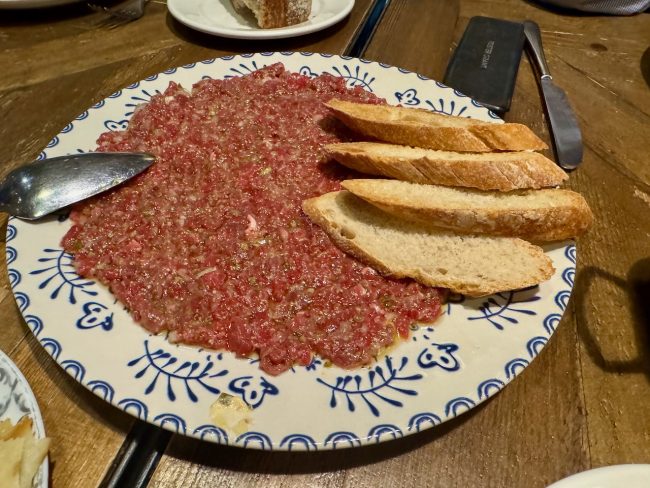
… and then consuming a perfectly grilled, medium rare ribeye with a side of fries and piquillo peppers. A wonderful dinner with even more wonderful conversation. Maribel and Phil have led quite a life, with a lot more on the horizon.
After all that, we did leave room for a brioche French toast with ice cream for dessert.
It turned out to be a late night with all that conversing … 
… and we did not return to our hotel until a little before midnight.
 We had to be up early the following morning because we were headed out of town to visit one of Spain’s most visited sites, the Royal Site of San Lorenzo de El Escorial. Wow! Then we would head back to Madrid for lunch at an old favorite from ten years ago. Fatigue once again reared its ugly head, and for the second straight day I would take a late afternoon snooze (what is happening to me?) Invigorated, and after hanging with Sebastián, we strolled the streets of our neighborhood, learning about why it is called “The Literary Quarter” and dining at an intimate and fantastic restaurant.
We had to be up early the following morning because we were headed out of town to visit one of Spain’s most visited sites, the Royal Site of San Lorenzo de El Escorial. Wow! Then we would head back to Madrid for lunch at an old favorite from ten years ago. Fatigue once again reared its ugly head, and for the second straight day I would take a late afternoon snooze (what is happening to me?) Invigorated, and after hanging with Sebastián, we strolled the streets of our neighborhood, learning about why it is called “The Literary Quarter” and dining at an intimate and fantastic restaurant.
Chapter Three: Royal Site of San Lorenzo de El Escorial
Day Three: Skipping The Bus, The Largest Renaissance Building In The World, Eighth Wonder Of the World, A Royal Library, Are We Already Back In Madrid, Would You Like Some Tonic In That?, A (Very) Short Walk In The Park, The Inside Scoop On Tapas, Happening ‘Hood, and The Mouthwatering Vinoteca






